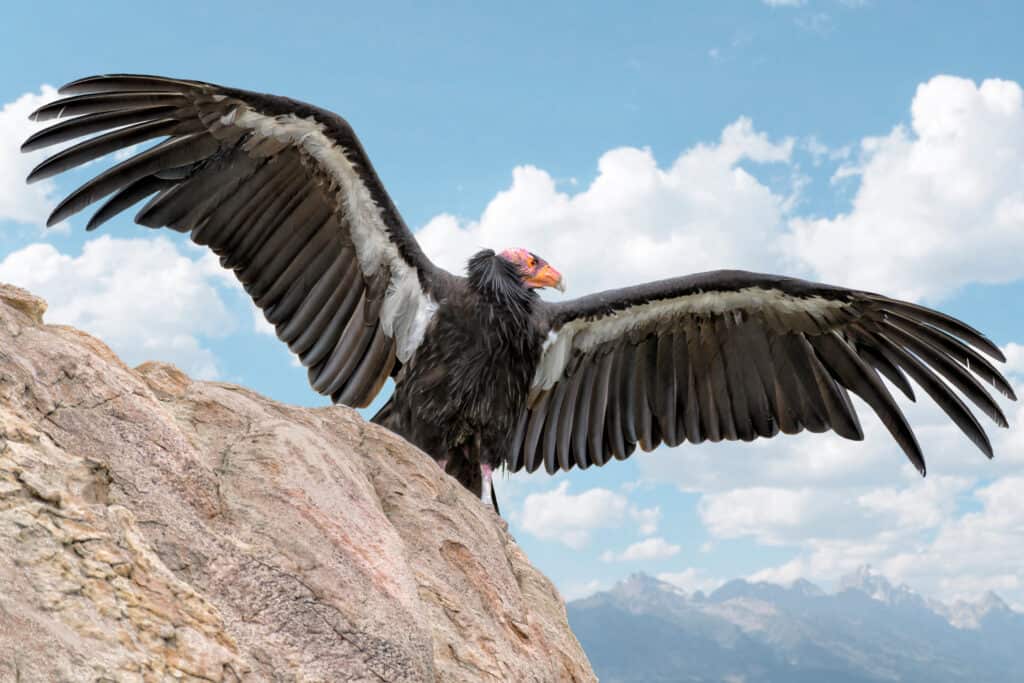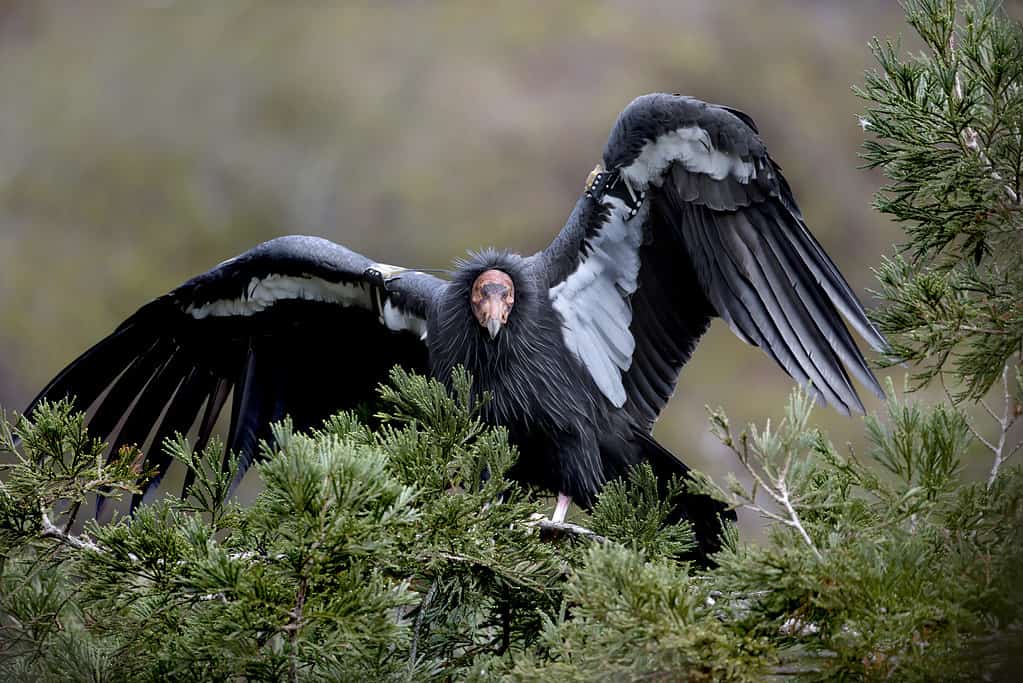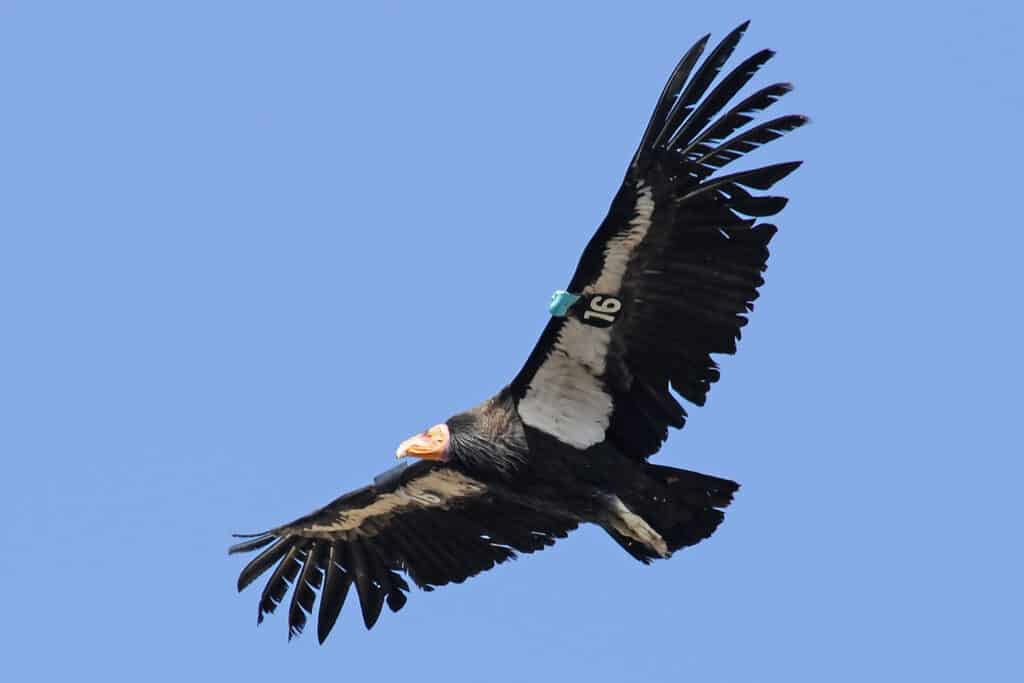The largest bird in North America, the California Condor, is also the rarest. Although these scavenger birds live off the dead carcasses of other animals, they are one of the world’s longest-living birds. Making their home in California, condors living in the wild number fewer than 240. Does this mean the rare condor will disappear from California?
Interesting Condor Facts
- California condors have the largest wingspan of any North American bird.
- These birds are so large they can be mistaken for a small plane.
- Condors can survive up to two weeks without eating. When they feed on a carcass, they can store up to three pounds of meat in their crop (part of the esophagus).
- These vultures can cover hundreds of miles each day in search of carcasses of large animals.
The California Condor in Native American Mythology

The rarest bird in California is prominent in Native American mythology.
©Barbara Ash/Shutterstock.com
The California Condor is an important symbol to Native Americans. In their mythology, the condor takes on different roles depending on which tribe tells the story.
For instance, the Yokuts people, native to central California, describe the bird as causing the lunar cycles by sometimes eating the moon; the wings of the condor cause eclipses. The Chumash people of southern California tell that the condor was originally white but became black when it flew too close to a fire. The Wiyot tribe in the northern region say the condor recreated humankind after a flood wiped them out. Finally, the Mono tribe of the Sierra Nevada region describes the condor as a destroyer that cuts off human heads to flood ground squirrel’s homes with their blood.
Spiritually significant to Native Americans, condor bones and feather headdresses have been found in Native American graves. Shamans wore ceremonial clothing made from condor feathers when they danced to reach the upper and lower spiritual worlds. New ceremonial clothing was created for each new shaman.
Scientific Name and Appearance
Gymnogyps californianus (California Condor) is a “New World” vulture in the Cathartidae family. As scavengers, these vultures feed mainly on the carcasses of dead animals. A keen sense of smell and sharp eyesight help them locate carrion.
The plumage of adult condors is predominantly black. Underneath the wings, a white triangular mark stretches from the body to the tip of the wing. Their heads and necks are featherless and pinkish-orange in color. Typically, condors weigh 20-25 pounds, making them one of the largest flying birds.
Habitat for This Rare Bird

California condors nest in high places, sometimes in giant sequoias.
©pjsells/iStock via Getty Images
In prehistoric times, you could find condors as far east as New York and Florida. Today, they mainly reside in the California deserts. However, you can also find them in Mexico, Utah, and Arizona.
These rare birds nest at high elevations (up to 6,000 feet above sea level). You can find their nests on rocky cliff faces, in caves, and sometimes in the cavities of giant sequoias.
As the American West opened up, settlers contributed to the condor’s decline by killing the birds, destroying their nests, and taking their eggs. Additionally, the wild-game population decreased as these newcomers hunted for food, resulting in a dwindling food supply for the condors.
Reproduction
The slow reproduction rate of the California condor contributes to its low population. Females will lay only one egg per nesting season and do not always nest every year. The egg takes two months to hatch, and the chick can fly after five to six months. The newborn will not live on its own for at least a year. A condor will not reach maturity for six to eight years.
This Rare Bird was Nearly-Extinct

Conservationists are rebuilding the population of the rarest bird in California.
©Brian A Wolf/Shutterstock.com
In the 1980s, the population of condors fell to just 22 birds in the wild. Slowly, conservationists worked to rebuild this rare bird population. In 1987, the United States government began a captive breeding program led by the San Diego Wild Animal Park and the Los Angeles Zoo. Other zoos around the country also participated.
Starting in 1991, California condors were released in California at Big Sur, Pinnacles National Park, and Bitter Creek National Wildlife Refuge.
Modern-day causes still contribute to the condors’ decline. Lead poisoning (from eating carcasses containing lead shot), DDT poisoning, electric power lines, and habitat destruction are only some of the obstacles these birds face. The leading cause of death for condor chicks is ingesting trash that is fed to them by their parents.
In October 2010, the wild condor population reached 100. The following year, that number rose to 205. By 2015, more condors were born in the wild than died, a key milestone. Today, the number of condors living in the wild in California is estimated to be approximately 240.
In 2020, the U.S. Fish and Wildlife Service estimated about 500 California condors worldwide, with about 330 in the wild. Captive populations have been established at Los Angeles, San Diego, and Oregon zoos. Thanks to the condor conservation program, the population of condors continues to grow again.
The photo featured at the top of this post is © George Lamson/Shutterstock.com
Thank you for reading! Have some feedback for us? Contact the AZ Animals editorial team.







